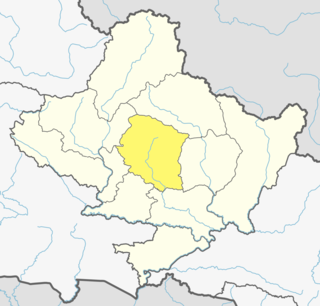Thakali may refer to:
- Thakali people, a people of Nepal
- Thakali language, their Sino-Tibetan language
Thakali may refer to:

Upper Mustang is an upper part of Mustang District, which is located in Nepal. The Upper Mustang was a restricted kingdom until 1992 which makes it one of the most preserved regions in the world, with a majority of the population still speaking traditional Tibetic languages. Tibetan culture has been preserved by the relative isolation of the region from the outside world. Life in Mustang revolves around tourism, animal husbandry, and trade.

The Thakali are an ethnolinguistic Tibeto-Burman ethnic group of Nepal. The traditional area of the Thakali community is called Thak-sat-se or the Thak Khola region and lies in the Kali Gandaki River valley in the Mustang District, Gandaki Province in western Nepal. According to the 2001 census, the Thakali population of around 12,973 constituted only 0.06% of Nepal's population. By the 2011 Nepal census, there were 13,215 Thakali people in Nepal.

Kaski District, a part of Gandaki Province, is one of the seventy-seven districts of Nepal. The name is disambiguated from Kaskikot, the ancient Kaski Kingdom.

Manang District (Nepali: मनाङ जिल्लाListen , a part of Gandaki Province, is one of the seventy-seven districts of Nepal. The district, with Chame as its district headquarters, covers an area of 2,246 km2 and had a population of 6,538.

Mustang District is one of the eleven districts of Gandaki Province and one of seventy-seven districts of Nepal which was a Kingdom of Lo-Manthang that joined the Federation of Nepal in 2008 after abolition of the Shah dynasty. It covers an area of 3,573 km2 (1,380 sq mi) and has a population (2011) of 13,452. The headquarters is located at Jomsom. Mustang is the 5th largest district of Nepal.

Baglung is a municipality in Gandaki Province, in western Nepal, 275 km (171 mi) west of Kathmandu. It is the administrative headquarters of Baglung District. Baglung serves as the major center for business, finance, education, service and healthcare for the people of mid-Kali Gandaki valley that encompass Beni, Jaljala, Baglung, Kushma, Kathekhola, Galkot, Phalewas and Jaimuni local bodies. The city is located at the cross-section of Kaligandaki corridor highway and midhill highway that transverse Nepal in north–south and east–west directions respectively.

Gurung, also known as Tamu Kyi or Tamu Bhaasaa, is a language spoken by the Gurung people of Nepal. The total number of all Gurung speakers in Nepal was 227,918 in 1991 and 325,622 in 2011.
Sarki/Mijar is an occupational caste in Nepal traditionally belonging to leather workers. They are found in the region of the Himalayas, Nepal, across the hills of Darjeeling & Kalimpong and in Terai area of Dooars. They are experts in playing their musical instrument "Madal" and performing dance in a group which is also called “Khayali Marooni”. According to the 2011 Nepal census, Sarki makes up 1.4% of Nepal's population. Sarki are referred to in the Nepali and Thakali languages.
SKJ may refer to:

Nepali cuisine comprises a variety of cuisines based upon ethnicity, alluvial soil and climate relating to Nepal's cultural diversity and geography. Dal-bhat-tarkari is eaten throughout Nepal. Dal is a soup made of lentils and spices, bhat — usually rice but sometimes another grain — and a vegetable curry, tarkari. Condiments are usually small amounts of spicy pickle which can be fresh or fermented, mainly of dried mustard greens and radish and of which there are many varieties. Other accompaniments may be sliced lemon (nibuwa) or lime (kagati) with fresh green chilli and a fried papad and also Islamic food items like rice pudding, sewai, biryani etc. Dhindo (ढिंडो) is a traditional food of Nepal. A typical example of Nepali cuisine is the Chaurasi Byanjan set where bhat (rice) is served in a giant leaf platter (patravali) along with 84 different Nepali dishes each served on small plates. It is mostly fed during weddings and Pasni(rice feeding ceremony).
Dhorpatan is a municipality in Nepal's Baglung District, 3,900 meters elevation in an east–west valley south of the Dhaulagiri mountain range in the Himalayas. It is the headquarters of Dhorpatan Hunting Reserve. There is a small community of indigenous Kham Magar people as well as Tibetan refugees.
Chhantyal is spoken by approximately 2,000 of the 10,000 ethnic Chhantyal in Nepal. Chhantyal is spoken in the Kali Gandaki River valley of Myagdi District; there are also ethnic Chantel in Baglung District (Ethnologue).
TGT may stand for:

Tikapur is a Municipality in Kailali District in Sudurpashchim Province of Nepal that was established in January 1997. Tikapur Municipality was further expanded on 10 March 2017 through merger with the two former Village development committees Narayanpur and Dansinhapur. It lies on the bank of Karnali River.
The Chhantyal are an indigenous people of Nepal. Chhantyals are considered an indigenous group by the Government of Nepal. Most of the Chhantyal dwellings are concentrated in the western part of the country. Baglung and Myagdi are two districts in the Dhaulagiri Zone where most of the Chhantyals are living. Other districts with Chhantyal habitation include Mustang, Gulmi, Rukum, and Parbat. Nowadays, owing to the migration trend there is a notable population of the Chhantyals in Kathmandu Valley, Pokhara, Rupandehi, Kaski, Dang and Chitwan districts. According to a survey conducted by its sole organization, Nepal Chhantyal Organization, the total population is 16,093 and 1,602 households. Traditionally Chhantyals have been living with other castes in harmony. In some villages Chhantyals are a major group whereas in other villages they are a minority. Chhantyals have their own culture, tradition, rituals, language, and religion.
The Tamangic languages, TGTM languages, or West Bodish languages, are a family of Sino-Tibetan languages spoken in the Himalayas of Nepal. They are called "West Bodish" by Bradley (1997), from Bod, the native term for Tibet. TGTM stands for Tamang-Gurung-Thakali-Manang.
Ralf-Stefan Georg is a German linguist. He is currently Professor at the University of Bonn in Bonn, Germany, for Altaic Linguistics and Culture Studies.
Seke might be:
Thakali is a Sino-Tibetan language of Nepal spoken by the Thakali people, mainly in the Myagdi and Mustang Districts. Its dialects have limited mutual intelligibility.
Seke may refer to: